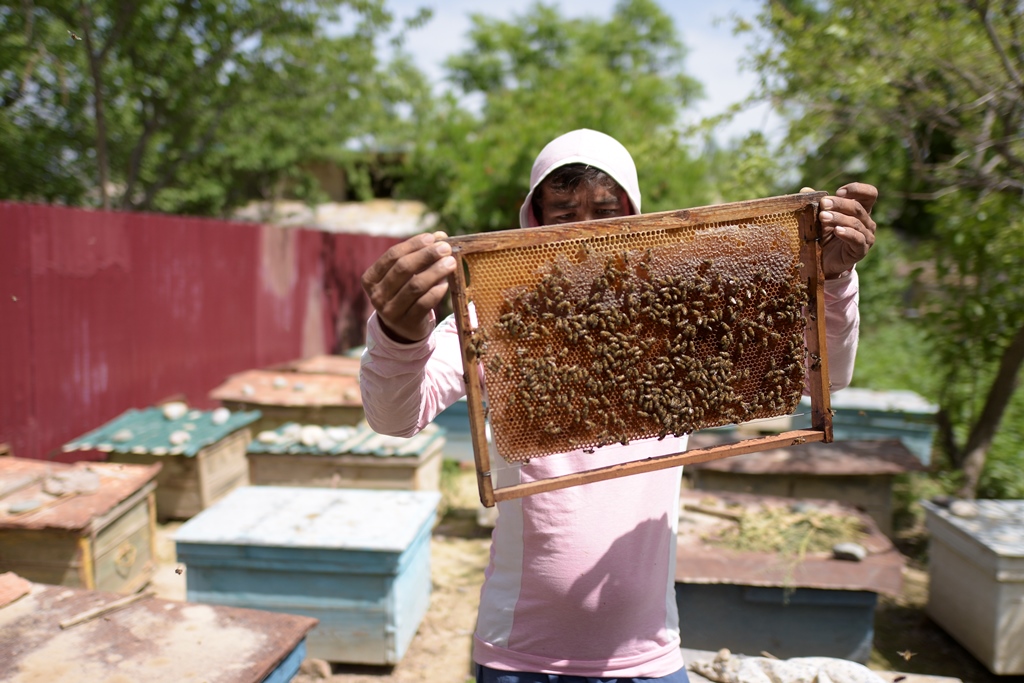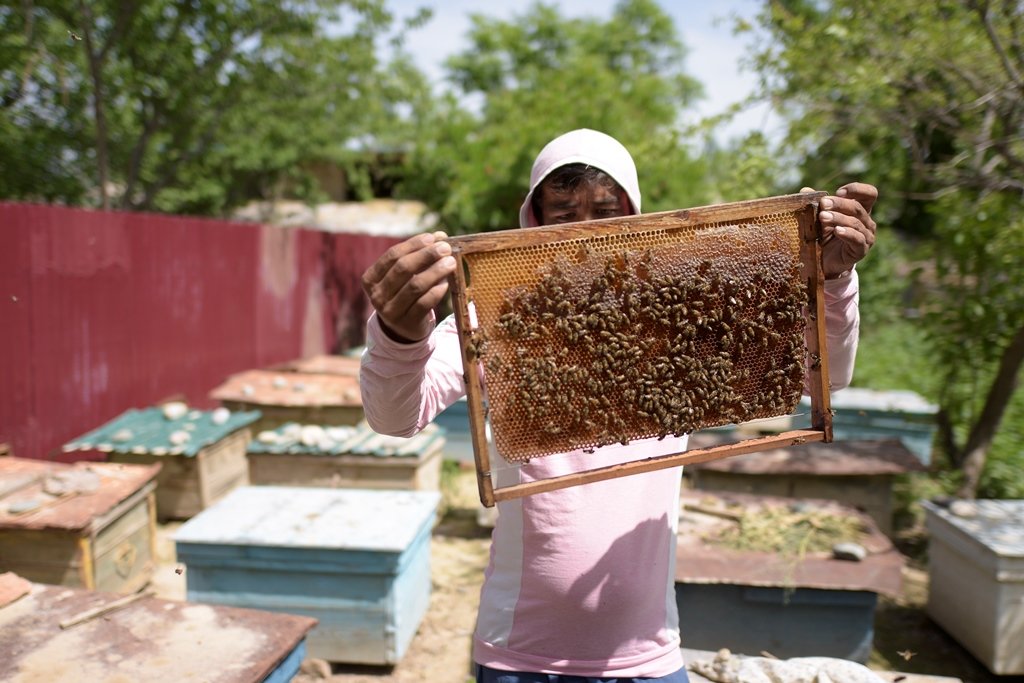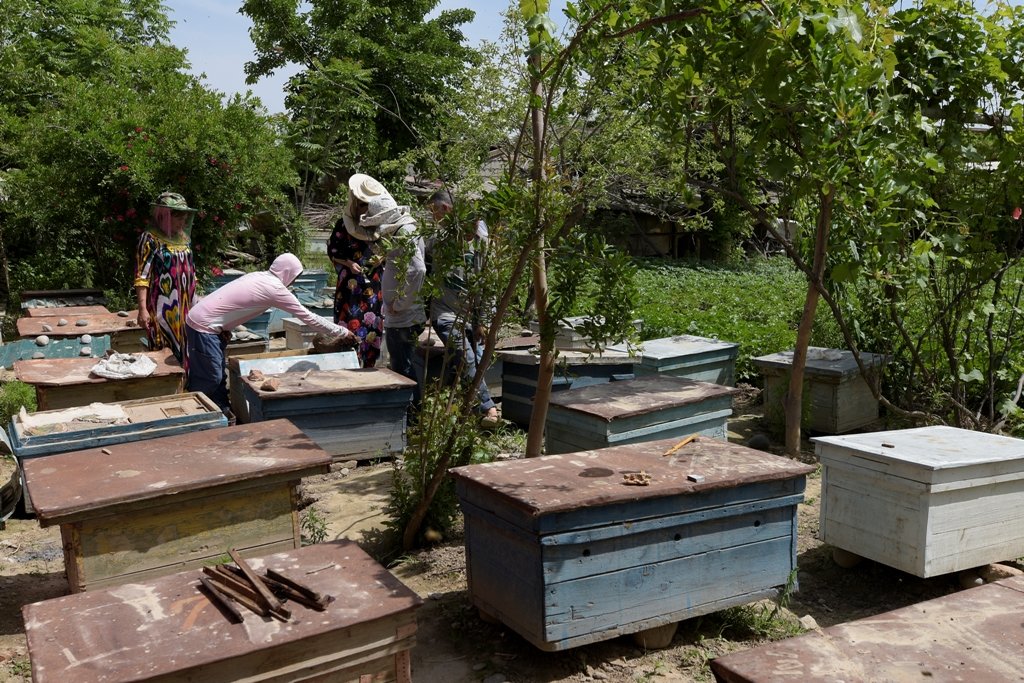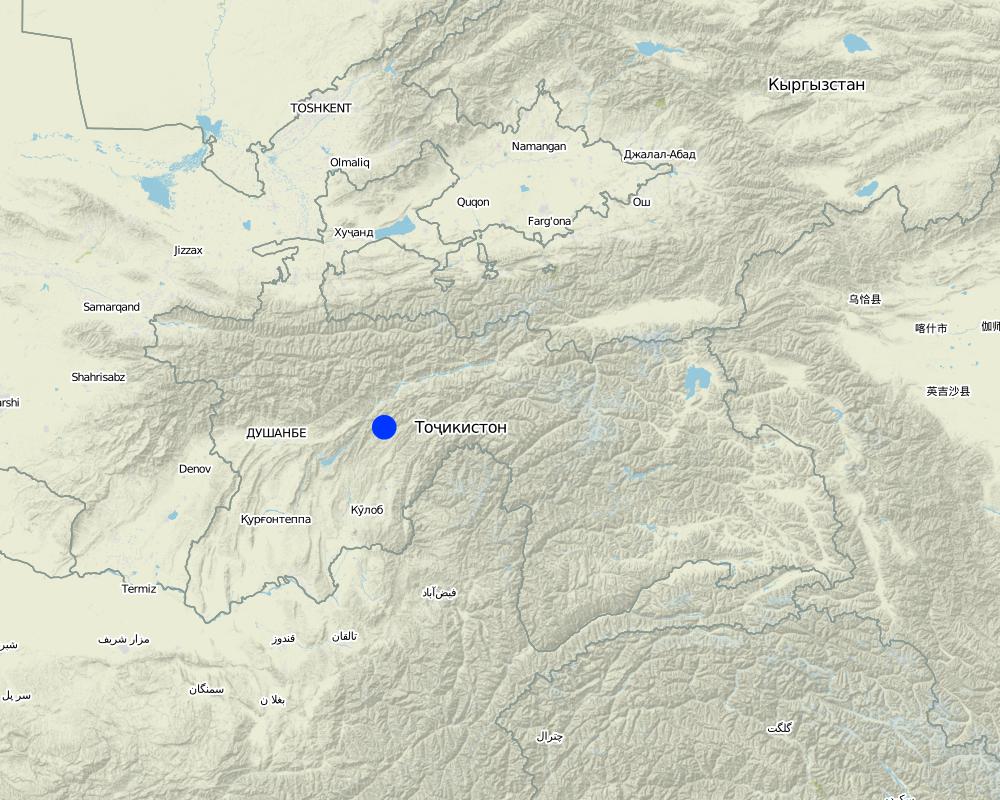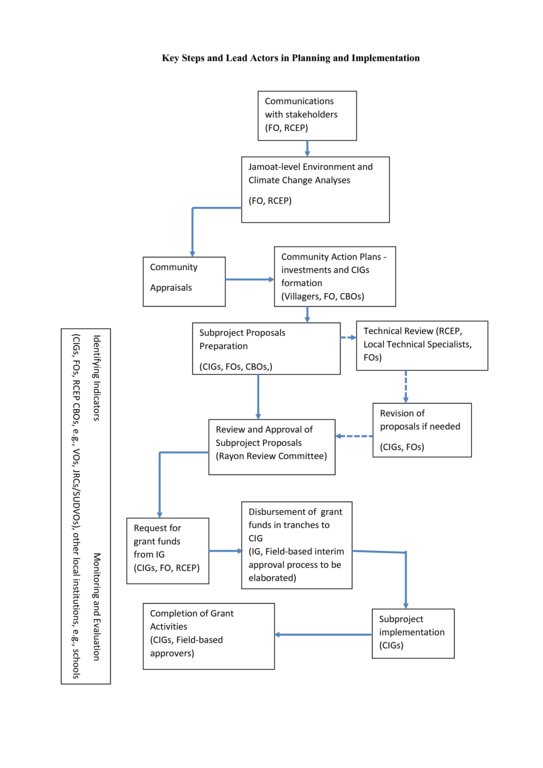Improving productivity of fruit trees through development beekeeping sector [Tajikistan]
- Creation:
- Update:
- Compiler: Kamolidin Abdulloev
- Editor: –
- Reviewer: Farrukh Nazarmavloev
Бехтар намудани самарраи дарахтони мевадиханда таввасути занбурпарвари
approaches_3887 - Tajikistan
View sections
Expand all Collapse all1. General information
1.2 Contact details of resource persons and institutions involved in the assessment and documentation of the Approach
Key resource person(s)
SLM specialist:
Name of project which facilitated the documentation/ evaluation of the Approach (if relevant)
Environmental Land Management and Rural Livelihoods (ELMAR)Name of the institution(s) which facilitated the documentation/ evaluation of the Approach (if relevant)
Committee for Environment Protection of Tajikistan (Committee for Environment Protection of Tajikistan) - Tajikistan1.3 Conditions regarding the use of data documented through WOCAT
When were the data compiled (in the field)?
22/06/2018
The compiler and key resource person(s) accept the conditions regarding the use of data documented through WOCAT:
Yes
2. Description of the SLM Approach
2.1 Short description of the Approach
Honeybee keeping improves pollination of trees, shrubs, and crops, which will increase the productivity of orchards, arable lands, grassland
2.2 Detailed description of the Approach
Detailed description of the Approach:
Beekeeping provides an opportunity to improve the economic use and ecosystem sanitation in the future. On the one hand, honeybee keeping improves pollination of trees, shrubs and crops, which will increase the productivity of orchards, arable lands, grassland and highland areas also households got high-quality honey and income. In addition, an approach is supporting households using the existing natural features, population improved their living standards by increasing the production of environmentally sound and high-quality honey, then sold at local markets.
Shaidon village has 238 households and 1651 people are living. Shaidon village is located at a distance of 35 km from the district center. According to statistics, the area of land used in the village is 886 hectares. Of these, 60 hectares are household plots, 26 hectares are private farms and 800 hectares occupy pastures. The population is engaged in breeding 470 heads of neat cattle, 520 heads of small cattle, 5 horses, 120 donkeys, 460 chickens and 60 turkeys. On average, each household has 0.08 ha of plots. The soil in the village is included in the category of gray soil. The annual rainfall in the village is up to 700 mm. Winter lasts for 3 months. The terrain is flat, the source of drinking water is groundwater and natural water resources.
An approach supported on behalf of the ELMARL Project. Shaidon village has expanded and favorable opportunities for the development of the beekeeping sector. and bee families were provided to 25 households that are the CIG members. And the CIG members considers that it necessary to strengthen the productivity of fruit trees in the village, through the development of beekeeping sector, as the result provided bee colonies (hives), appropriate uniforms and supplies, wax and medicines, so that ensure the production of ecologically pure honey, the appearance of additional income and new working places. Farmers have purchased the following units under the Project: 25 hives, 25 bee colonies, 1 pc. smothe king device, 1 pc. special device for collecting honey, 15 pcs. protective clothing, 150 kg of sugar and medicines the purchase of which as well transportation of hives and bee families from Khatlon region were funded by the Project. Arrangement, moving and care of bees is assigned to the farmers.
2.3 Photos of the Approach
General remarks regarding photos:
Shaidon village has expanded and favorable opportunities for the development of the beekeeping sector
2.5 Country/ region/ locations where the Approach has been applied
Country:
Tajikistan
Region/ State/ Province:
Kulob Region, Baljuvon District
Further specification of location:
Sari Khosor jamoat, Shaidon village
Comments:
The approach will be implemented in the Shaidon village
Map
×2.6 Dates of initiation and termination of the Approach
Indicate year of initiation:
2016
Year of termination (if Approach is no longer applied):
2017
Comments:
This approach has been implemented on a project base and during the 2 years monitored and controlled. The CIG gives this responsibility and will manage and maintain it in future
2.7 Type of Approach
- project/ programme based
2.8 Main aims/ objectives of the Approach
Enhancing productivity of the orchards, arable lands, grassland and highland areas and improve the economic use and ecosystem sanitation in the future by developing beekeeping
2.9 Conditions enabling or hindering implementation of the Technology/ Technologies applied under the Approach
social/ cultural/ religious norms and values
- enabling
Before the project people besides the income did not think about the other issues like environment and productiveness of the orchards and agriculture lands
Proposed approach change their minds to think broader, through supporting them with the training and also beekeeping equipment
availability/ access to financial resources and services
- enabling
For now not
But in the near future, they will have the opportunity for the availability of the income, as the group trying to increase the number of the beehives.
institutional setting
- enabling
The CIG group is formed and will manage and maintain the approach
knowledge about SLM, access to technical support
- hindering
Lack of knowledge on SLM approaches and technologies
Organised and provided the different type of SLM relative trainings on behalf of the project but iy is steel an issue
3. Participation and roles of stakeholders involved
3.1 Stakeholders involved in the Approach and their roles
- local land users/ local communities
CIG members (local farmers)
Local farmers prioritized investments based on a fixed budget for each type of rural investment determined by the number of households. Within a plan of action, participants decided on the allocation of investments to groups of households using rules that limit the funding for any one household.
All activities, including PRA, training and investment subprojects involved men and women with due a diligence. Social safety was assured for the people with disabilities, who participated in rural livelihoods activities and had equal rights and voices.
- SLM specialists/ agricultural advisers
Facilitating organizations and academy of science
Representatives from the facilitating organizations and professors (as TOT trainers) from the Institutions and academies involved during the training
- local government
Jamoat representative, Hukumat of the district departments
Jamoat representatives were involved in Participatory Rural Appraisal (PRA) that was used as the main pre-assessment mechanism to analyze the socio-economic and environmental situation in the selected pilots,
The RRC(Rayon Review Committee) will consider the combination of proposed sub-projects within the overall context of the rayon and project. The committee will review and accept proposals that meet project guidelines and provide clearance to the Project Staff for the release of project funding to the accounts of relevant CIGs.
3.2 Involvement of local land users/ local communities in the different phases of the Approach
| Involvement of local land users/ local communities | Specify who was involved and describe activities | |
|---|---|---|
| planning | passive | Project beneficiaries (CIG Members) interviewed and consulted during the social assessment conducted in the project design process which then influenced project approaches. |
| implementation | interactive | Villagers (CIG Members) made grant allocation decisions. CIGs managed grant funds and purchased needed materials and products individually |
| monitoring/ evaluation | passive | CIGs participated during the monitoring activity |
3.3 Flow chart (if available)
Description:
Here is the key steps and actors in the planning and implementation of rural investments. Not all possible participants in these steps are included since local situations may vary and will need to be taken into account during planning and implementation.
Author:
ELMARL POM
3.4 Decision-making on the selection of SLM Technology/ Technologies
Specify who decided on the selection of the Technology/ Technologies to be implemented:
- mainly land users, supported by SLM specialists
Explain:
Villagers prioritized investments based on a fixed budget for each type of rural investment determined by the number of households. Within a plan of action, participants decided on the allocation of investments to groups of households (Common Interest Groups, CIGs) using rules that limit the funding for any one household.
Specify on what basis decisions were made:
- evaluation of well-documented SLM knowledge (evidence-based decision-making)
4. Technical support, capacity building, and knowledge management
4.1 Capacity building/ training
Was training provided to land users/ other stakeholders?
Yes
Specify who was trained:
- land users
- field staff/ advisers
If relevant, specify gender, age, status, ethnicity, etc.
Specialists from the FOs used mechanisms that provided full participation, women, and men in all sessions
Form of training:
- on-the-job
- farmer-to-farmer
Subjects covered:
Grant allocation mechanisms. Fund flow arrangements, management and technical, SLM training
Comments:
Training included such king themes;
composting, mulching, managing salinization, intercropping on slopes, drip irrigation, low-cost watering techniques, solar greenhouses, drought-resistant crops, bee-keeping, mixed fruit orchards, local varieties nurseries, rotational grazing, Livestock breeding and maintaining, strategic watering points, use of perennial forage, solar energy technologies, marketing options and opportunities
4.2 Advisory service
Do land users have access to an advisory service?
Yes
Specify whether advisory service is provided:
- at permanent centres
Describe/ comments:
Jamoat reprezentatives advise CIG members and support them in realisation their plans
4.3 Institution strengthening (organizational development)
Have institutions been established or strengthened through the Approach?
- yes, a little
Specify the level(s) at which institutions have been strengthened or established:
- local
Describe institution, roles and responsibilities, members, etc.
The Common Interest Groups formed in the villages on behalf households and enhanced their knowledge. And the project provides small-scale grants at the village level for groups of households (CIG) to implement rural production and land management investments, as well as related small-scale infrastructure investments. Villages prioritized investments based on a fixed budget for each type of rural investment, determined by the number of households.
Specify type of support:
- financial
- capacity building/ training
Give further details:
Project-financed grants to CIGs for each investment under categories of rural production and land management investments, as well as related small-scale infrastructure investments that will not exceed US$7,000 and will require a match of 25% in beneficiary contributions which may be in cash or in-kind
4.4 Monitoring and evaluation
Is monitoring and evaluation part of the Approach?
Yes
Comments:
Grant allocation, number of beneficiaries, Estimated costs of rural investments, environmental aspects, management of the investments
If yes, is this documentation intended to be used for monitoring and evaluation?
Yes
Comments:
Rural investment monitoring should focus on the range of issues relevant to subproject sustainability, including environmental, social and economic. FOs build CIG capacities to monitor these aspects and to adapt to changing conditions.
4.5 Research
Was research part of the Approach?
No
5. Financing and external material support
5.1 Annual budget for the SLM component of the Approach
If precise annual budget is not known, indicate range:
- 2,000-10,000
Comments (e.g. main sources of funding/ major donors):
GEF/PPCR through WB
5.2 Financial/ material support provided to land users
Did land users receive financial/ material support for implementing the Technology/ Technologies?
Yes
If yes, specify type(s) of support, conditions, and provider(s):
The project provided small-scale grants at the village level for groups of households to implement rural production and land management investments, as well as related small-scale
infrastructure investments.Villages prioritized investments based on a fixed budget for each type of rural investment, determined by the number of households.
Mechanism: The Common Interest Groups formed at village level on behalf of households and enhanced their knowledge. Further project financed CIG with the small grants under the three main categories of activities that are expected to contribute to their assets and sustainable land management, and increase climate resilience.
An approach/subproject been supported grant amount 7,000 USD and implemented through the Common Interest Group (CIG). CIG have contributed more then 25% from the total approach/subproject amount.
5.3 Subsidies for specific inputs (including labour)
- none
If labour by land users was a substantial input, was it:
- voluntary
Comments:
As mentioned above beneficiary contribution was in-kind the 25% of the total subproject amount
5.4 Credit
Was credit provided under the Approach for SLM activities?
No
5.5 Other incentives or instruments
Were other incentives or instruments used to promote implementation of SLM Technologies?
Yes
If yes, specify:
Study tours, competition farmer to farmer
6. Impact analysis and concluding statements
6.1 Impacts of the Approach
As a result of the approach, mainly households got high-quality honey, and 25 households got jobs. On the other hand, using the existing natural features, population improved their living standards by increasing the production of environmentally sound and high-quality honey, then sold at local markets. In addition productivity will be increased from the fruit trees and also agriculture lands that will be another income to the local land users.
Did the Approach help land users to implement and maintain SLM Technologies?
- No
- Yes, little
- Yes, moderately
- Yes, greatly
During the project implementation training and meetings were organized with the CIG (local people) that will give them the opportunity to manage and maintain on hand approach
Did the Approach improve knowledge and capacities of land users to implement SLM?
- No
- Yes, little
- Yes, moderately
- Yes, greatly
All the trainings (composting, mulching, managing salinization, intercropping on slopes, drip irrigation, low-cost watering techniques, solar greenhouses, drought-resistant crops, bee-keeping, mixed fruit orchards, local varieties nurseries, rotational grazing, Livestock breeding and maintaining, strategic watering points, use of perennial forage) that have provided during the project implementation linked somehow to the SLM. And CIG members trying all their best to increase the number of the beehives and expand approach among other villagers
6.2 Main motivation of land users to implement SLM
- increased production
Villagers have expanded and favorable opportunities for the development of beekeeping sector as honeybee keeping improves pollination of trees, shrubs, and crops, which will increase the productivity of orchards, arable lands, grassland and highland areas.a
- enhanced SLM knowledge and skills
Villagers have expanded and favorable opportunities for the development of beekeeping sector as honeybee keeping improves pollination of trees, shrubs, and crops, which will increase the productivity of orchards, arable lands, grassland and highland areas.
6.3 Sustainability of Approach activities
Can the land users sustain what has been implemented through the Approach (without external support)?
- yes
If yes, describe how:
Because before starting of the project "participatory rural appraisal" within ELMARL project was the first steps to the sustainability because the villagers identify and prioritize development needs. This meaning that from the beginning villagers involved and even by them made grant allocation decisions, also CIGs managed grant funds and bought inputs.. Maintaining actions are in place
6.4 Strengths/ advantages of the Approach
| Strengths/ advantages/ opportunities in the land user’s view |
|---|
| Sufficient climate of the place and experianced CIG specialists is the garanty of the activity and sustainibility of the approach |
| Strengths/ advantages/ opportunities in the compiler’s or other key resource person’s view |
|---|
| Collecting people in one Group(CIG), gives opportunity to do desicions together and expanding approach in the plan |
| Capacity building events that was organised during the approach, new technologies, new knowledges and so on |
| Good cooperation with the jamoat |
6.5 Weaknesses/ disadvantages of the Approach and ways of overcoming them
| Weaknesses/ disadvantages/ risks in the land user’s view | How can they be overcome? |
|---|---|
| Bees diseases | Needs more training and support on behalf of the district hukumat and projects |
| Weaknesses/ disadvantages/ risks in the compiler’s or other key resource person’s view | How can they be overcome? |
|---|---|
| Market, value chance, preparation of the business plans and other reletive knowledges they need | Other coming projects or local hukumat needs to support them |
7. References and links
7.1 Methods/ sources of information
- compilation from reports and other existing documentation
Existed project documents and reports
7.2 References to available publications
Title, author, year, ISBN:
ELMARL Annual Report 2017
Available from where? Costs?
CEP of RT, free
7.3 Links to relevant information which is available online
Title/ description:
ELMARL Annual Report 2017
Links and modules
Expand all Collapse allLinks
No links
Modules
No modules


